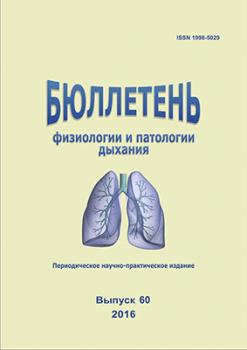Blagoveschensk, Blagoveshchensk, Russian Federation
Blagoveschensk, Blagoveshchensk, Russian Federation
Blagoveschensk, Blagoveshchensk, Russian Federation
The aim of the research was to identify the frequency of development of the syndrome of post-exercise bronchial spasm in patients with asthma against physical load and the study of clinical-functional features of its course. 197 patients (122 women and 75 men) with mild persistent partially controlled and uncontrolled asthma were observed. The mean age of the patients was 36.1±0.73 years old; the mean height was 168.8±0.63 cm; the mean weight was 74.6±1.03 kg. The patients did not have strong obstructive disorders of the ventilation pulmonary function; forced expiratory volume for the first second (FEV1) was 91.6±2.5% from the predicted value. All the patients had clinical-anamnestic test and the assessment of apnoea degree by the scale of mMRC and identification of disease control by validated questionnaire Asthma Control Test; the airway response was evaluated in reaction to dosed physical load calculated and fulfilled at the research complex for ergospirometric studies OxyconPro (VIASYS Healthcare, Germany); basic study of the lung function at the device Easyone-PC (Switzerland) was done. As a result of the study post-exercise bronchial spasm was diagnosed in 18.3% of patients with asthma. Close positive correlation between the baseline FEV1 (in %) and bronchial response to the dosed physical load measured at the first minute of the recovery period (r=0.19; р<0.05) as well as the intensity of the further bronchial response at the 10th minute of the recovery period (r=0.19; р<0.05) was registered. The intensity of bronchial response at the 10th minute of the recovery period in patients with airway hyperresponsiveness to dosed physical load was directly related with the degree of asthma control (r=0.56; р˂0.05). It was found out that the degree of the asthma control correlated with the airway hyperresponsiveness to physical load.
asthma, bronchial hyperresponsiveness, exercise load, asthma control
1. Аfanas´eva Е.Yu., Prikhodko A.G., Perelman J.M., Nakhamchen L.G. Comparative characteristic of clinical and functional features of formation of hypo- and hyperosmolar airway responsiveness in patients with bronchial asthma. Bûlleten´ fiziologii i patologii dyhaniâ 2015; 56:8-13 (in Russian).
2. Vishnevetskiy I.I., Dyadyk А.I. Diagnosis and treatment of bronchial asthma according to GINA recommendations. Available at: http://med-obuch.kz/diagnostika-i-lechenie-bronkhialnoy-a/ (in Russian).
3. Global Initiative for Asthma (GINA). Global strategy for asthma management and prevention (Updated 2014). Available at: www.ginasthma.com.
4. Nekrasov E.V., Perelman J.M., Prikhodko A.G., Zakharova E.V., Makarova G.A. Mucin secretion in the nasal mucosa in response to cold air hyperventilation in asthmatics with different degrees of asthma control and disease severity. Bûlleten´ fiziologii i patologii dyhaniâ 2014; 53:42-49 (in Russian).
5. Perelman N.L. Quality of life in patients with bronchial asthma as a factor of disease control prediction. Bûlleten´ fiziologii i patologii dyhaniâ 2009; 33:30-33 (in Russian).
6. Pirogov A.B., Semirech J.O. Bronchial asthma control achievement in patients with cold airway hyperresponsiveness. Bûlleten´ fiziologii i patologii dyhaniâ 2009; 33:27-29 (in Russian).
7. Prikhodko A.G., Perelman J.M., Kolosov V.P. Airway hyperresponsiveness. Vladivostok: Dal´nauka; 2011 (in Russian).
8. ATS/ACCP statement on cardiopulmonary exercise testing. Am. J. Respir. Crit. Care Med. 2003; 167(2):211-277.
9. Bikov A., Gajdócsi R., Huszár É., Szili B., Lázár Z., Antus B., Losonczy G., Horváth I. Exercise increases exhaled breath condensate cysteinyl leukotriene concentration in asthmatic patient. J. Asthma 2010; 47(9):1057-1062.
10. Duong M., Subbarao P., Adelroth E., Obminski G., Strinich T., Inman M., Pedersen S., O´Byrne P.M. Sputum eosinophils and the response of exercise-induced bronchoconstriction to corticosteroid in asthma. Chest 2008; 133(2):404-411.
11. Gotshall R.W. Exercise-induced bronchoconstriction. Drugs 2002; 62(12):1725-1739.
12. Guidelines for methacholine and exercise challenge testing 1999. American Thoracic Society. Am. J. Respir. Crit. Care Med. 2000; 161(1):309-329.
13. Hallstrand T.S. New insights into pathogenesis of exercise-induced bronchoconstriction. Curr. Opin. Allergy Clin. Immunol. 2012: 12(1):42-48.
14. Miller M.R., Crapo R., Hankinson J., Brusasco V., Burgos F., Casaburi R., Coates A., Enright P., van der Grinten C.P., Gustafsson P., Jensen R., Johnson D.C., MacIntyre N., McKay R., Navajas D., Pedersen O.F., Pellegrino R., Viegi G., Wanger J. General considerations for lung function testing. Eur. Respir. J. 2005; 26(1):153-161.
15. Parsons J.P., Hallstrand T.S., Mastronarde J. G., Kaminsky D.A., Rundell K.W., Hull J.H., Storms W.W., Weiler J.M., Cheek F.M., Wilson K.C., Anderson S.D. An official American Thoracic Society clinical practice guideline: Exercise-induced bronchoconstriction. Am. J. Respir. Crit. Care Med. 2013; 187(9):1016-1027.
16. Vianna E.O., Boaventura L.C., Terra-Filho J., Nakama G.Y., Martinez J.A.B., Martin R.J. Morning-to-evening variation in exercise-induced bronchospasm. J. Allergy Clin. Immunol. 2002; 110(2):236-240.





